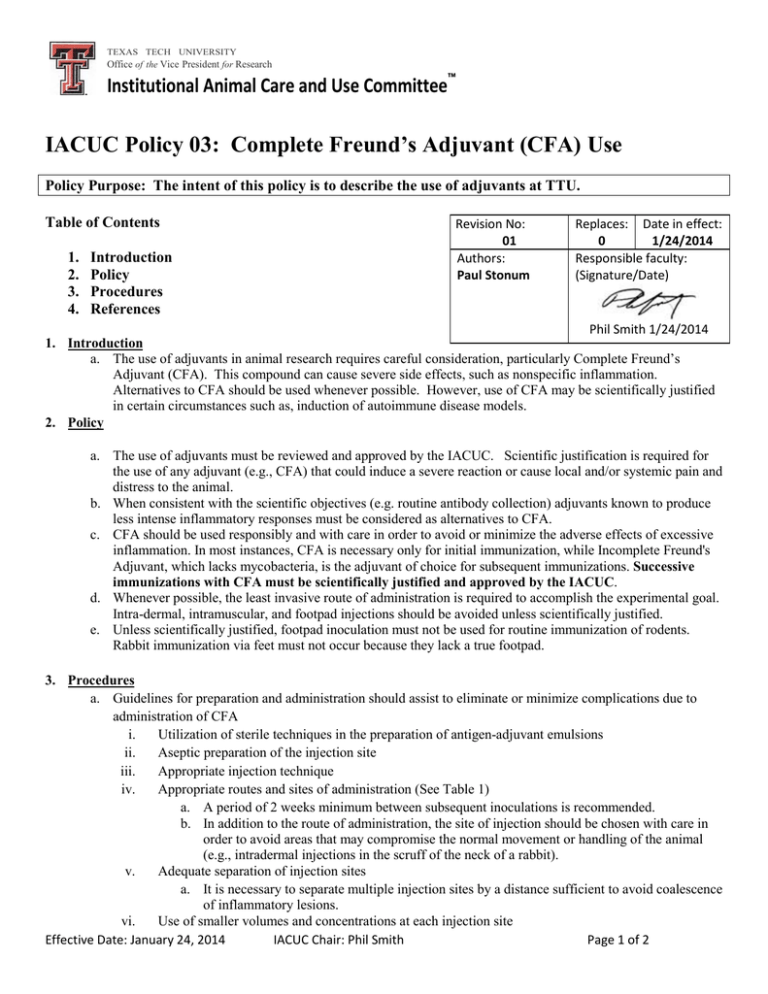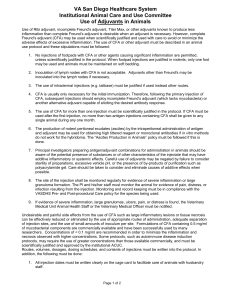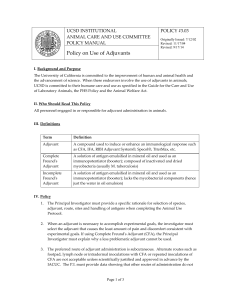IACUC Policy 03: Complete Freund’s Adjuvant (CFA) Use
advertisement

TEXAS TECH UNIVERSITY Office of the Vice President for Research Institutional Animal Care and Use Committee™ IACUC Policy 03: Complete Freund’s Adjuvant (CFA) Use Policy Purpose: The intent of this policy is to describe the use of adjuvants at TTU. Table of Contents 1. 2. 3. 4. Introduction Policy Procedures References Revision No: 01 Authors: Paul Stonum Replaces: Date in effect: 0 1/24/2014 Responsible faculty: (Signature/Date) Phil Smith 1/24/2014 1. Introduction a. The use of adjuvants in animal research requires careful consideration, particularly Complete Freund’s Adjuvant (CFA). This compound can cause severe side effects, such as nonspecific inflammation. Alternatives to CFA should be used whenever possible. However, use of CFA may be scientifically justified in certain circumstances such as, induction of autoimmune disease models. 2. Policy a. The use of adjuvants must be reviewed and approved by the IACUC. Scientific justification is required for the use of any adjuvant (e.g., CFA) that could induce a severe reaction or cause local and/or systemic pain and distress to the animal. b. When consistent with the scientific objectives (e.g. routine antibody collection) adjuvants known to produce less intense inflammatory responses must be considered as alternatives to CFA. c. CFA should be used responsibly and with care in order to avoid or minimize the adverse effects of excessive inflammation. In most instances, CFA is necessary only for initial immunization, while Incomplete Freund's Adjuvant, which lacks mycobacteria, is the adjuvant of choice for subsequent immunizations. Successive immunizations with CFA must be scientifically justified and approved by the IACUC. d. Whenever possible, the least invasive route of administration is required to accomplish the experimental goal. Intra-dermal, intramuscular, and footpad injections should be avoided unless scientifically justified. e. Unless scientifically justified, footpad inoculation must not be used for routine immunization of rodents. Rabbit immunization via feet must not occur because they lack a true footpad. 3. Procedures a. Guidelines for preparation and administration should assist to eliminate or minimize complications due to administration of CFA i. Utilization of sterile techniques in the preparation of antigen-adjuvant emulsions ii. Aseptic preparation of the injection site iii. Appropriate injection technique iv. Appropriate routes and sites of administration (See Table 1) a. A period of 2 weeks minimum between subsequent inoculations is recommended. b. In addition to the route of administration, the site of injection should be chosen with care in order to avoid areas that may compromise the normal movement or handling of the animal (e.g., intradermal injections in the scruff of the neck of a rabbit). v. Adequate separation of injection sites a. It is necessary to separate multiple injection sites by a distance sufficient to avoid coalescence of inflammatory lesions. vi. Use of smaller volumes and concentrations at each injection site Effective Date: January 24, 2014 IACUC Chair: Phil Smith Page 1 of 2 TEXAS TECH UNIVERSITY Office of the Vice President for Research Institutional Animal Care and Use Committee™ a. Formulations of CFA containing 0.5 mg/ml of mycobacterial components are commercially available and have been successfully used by many researchers. However, concentrations of < 0.1 mg/ml are recommended in order to minimize the inflammation and necrosis observed with higher concentrations. Some protocols, such as autoimmune disease induction protocols, may require the use of greater concentrations than those available commercially. b. For favorable results using CFA while minimizing undesirable side effects, use the recommended injection volumes and sites appropriate for the species, size of the animal, and experimental goal (see Table 1). Some routes of injection may potentially be less disruptive to the animal than other routes (e.g., subcutaneous injection vs. foot-pad administration) b. Post-injection observations i. As a result of CFA injection, pain and distress or injection site complication may occur. Animals should be observed post injection for up to 4 weeks minimum. Supportive care may include topical cleaning, antibiotics or analgesics. ii. If the animal is experiencing obvious pain or distress, the AV should consider narcotic opioids for analgesic (taking into account the research objective). c. Personnel Safety i. CFA contains mycobacterial components and could present an occupational hazard to laboratory personnel that would be preparing or administering the agent. ii. Laboratory personnel should be appropriately trained to handle, administer and dispose of the product. iii. Accidental needle punctures have resulted in clinical pain, inflammatory lesions and abscesses in individuals which are tuberculin-positive. Accidental CFA exposure has also resulted in tuberculinnegative individuals subsequently testing positive to TB tests. iv. Institutional Biosafety Committee (IBC) approval may be required for CFA use. Contact Matt Roe matt.roe@ttu.edu for additional information. Table 1. Recommended Volume (ml) of Adjuvant-Antigen Emulsion per Site According to Species CFA is not to be injected intravenously Species SubQ Intradermal Intraperitoneal Footpad Intramuscular Mouse <0.1 Not permitted <0.2 <0.05* Not recommended Rat <0.1 <0.05* Not recommended <0.5 <0.1* Not recommended Rabbit <0.25 <0.05* Not permitted Not permitted <0.5** Pig Not recommended 1.0 * Only when justified scientifically ** Only one limb recommended unless justified scientifically 4. References • • • • • • PHS Policy on Humane Care and Use of Laboratory Animals Guide for the Care and Use of Laboratory Animals, 8th Edition Institutional Animal Care and Use Committee Guidebook, 2nd Edition, 2002. http://oacu.od.nih.gov/ARAC/documents/Adjuvants.pdf http://www.ccac.ca/en_/standards/policies/policy-immunological_procedures http://www.ohsu.edu/xd/about/services/integrity/policies/upload/Adjuvant-use-2012_02_13-c.pdf Effective Date: January 24, 2014 IACUC Chair: Phil Smith Page 2 of 2



